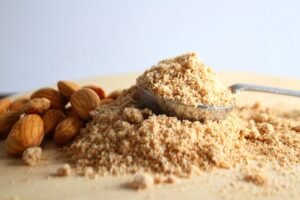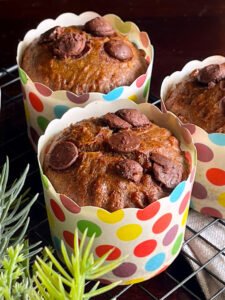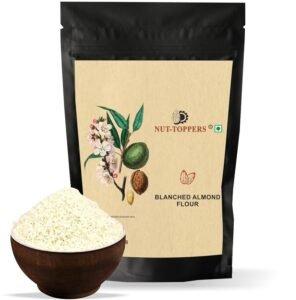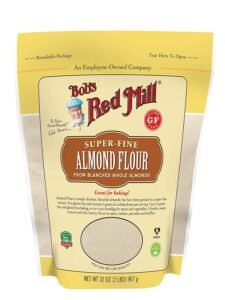Gluten-free baking has gained immense popularity, and almond flour has emerged as a favorite among health-conscious bakers. Whether you’re avoiding gluten due to dietary restrictions or exploring healthier alternatives, almond flour offers a delicious, nutritious, and naturally gluten-free option. Its mild, nutty flavor and fine texture make it an excellent choice for cakes, cookies, and even savory dishes.
In this guide, we’ll dive deep into everything you need to know about almond flour—its benefits, how to use it, best practices, and expert tips to ensure successful gluten-free baking every time.
What is Almond Flour?
Almond flour is made from blanched almonds that have been finely ground into a soft, flour-like consistency. Unlike almond meal, which contains almond skins and has a coarser texture, almond flour is smooth and ideal for delicate baked goods.
Before

After

Types of Almond Flour:
- Blanched Almond Flour – Made from peeled almonds, giving it a fine, light texture.
- Unblanched Almond Flour – Contains almond skins, offering a slightly denser and more rustic texture.
Why Choose Almond Flour for Gluten-Free Baking?
- Naturally Gluten-Free – Safe for people with celiac disease or gluten sensitivity.
- Nutrient-Dense – Rich in protein, fiber, healthy fats, and essential vitamins.
- Low-Carb & Keto-Friendly – A great alternative for those following low-carb diets.
- Moisture-Retaining – Produces soft, tender, and rich-textured baked goods.
- Mild Nutty Flavor – Enhances both sweet and savory recipes.
Nutritional Benefits of Almond Flour
Almond flour is more than just a gluten-free alternative; it’s packed with health benefits:
- High in Protein – Helps with muscle repair and satiety.
- Rich in Healthy Fats – Promotes heart health and sustained energy.
- Low in Carbs – Ideal for keto and low-carb diets.
- Packed with Vitamin E – Supports skin health and has antioxidant properties.
- Good Source of Magnesium – Helps regulate blood sugar and supports nerve function.
Delicious Gluten-Free & Egg-Free Almond Flour Muffins
Welcome to a delightful baking adventure featuring almond flour as the star ingredient! These gluten-free and egg-free almond muffins are perfect for those with dietary restrictions or anyone looking to enjoy a wholesome treat. Almond flour not only adds a rich, nutty flavor but also boosts the muffins’ nutritional profile, making them a fantastic choice for breakfast, snacks, or even a sweet indulgence.
This easy recipe combines the goodness of blanched almond flour and buckwheat flour for a deliciously tender texture, while flax seed powder serves as a perfect egg substitute, ensuring these muffins rise beautifully. Infused with the warm flavors of vanilla and sweetened naturally with honey, these muffins will satisfy your sweet cravings without any guilt.
Whether you’re a seasoned baker or a beginner, this recipe for almond muffins is sure to become a cherished addition to your gluten-free repertoire. Let’s dive in and whip up some scrumptious muffins that everyone will love!
Ingredients:
- Flax Seed Powder: 35g + Warm Water: 110gms
- Blanched Almond Flour: 185gms
- Buckwheat Flour: 85gms
- Powder Sugar: 100gms
- Baking Soda: ½ tsp
- Xanthan Gum: 2gms
- Honey: 105gms
- Virgin Coconut Oil: 30gms
- Vanilla Extract: 1 tsp
- Apple Cider Vinegar: 2 tsp
- Coconut Milk: 80gms
- Choco Chips: 50gms
Notes:
Please note that the cup measurements are approximate and can vary based on how ingredients are packed into the cups. Weights (in grams) are often more precise for baking.
Method:
- In a bowl, mix the flaxseed powder with warm water and let it sit for 10 minutes.
- In a mixing bowl sift together – Blanched Almond Flour, Buckwheat Flour, Powder Sugar, Baking Soda, and Xanthan.
- Make a well in the centre. Add the flax gel, Honey, Virgin Coconut Oil, Vanilla Extract, Apple Cider Vinegar, Coconut Milk, and Choco Chips.
- Use a spatula to blend until just combined. Don’t overmix; it can make the muffins too dense.
- Cover the bowl and leave the batter aside to rest for 10 mins.
- Preheat the oven to 160 C/ 320°F.
- Now, pour the batter into the muffin cups @ 125gms batter in each approx. Depends on the size of the muffin cups. OR Fill muffin cups 3/4 full.
- Bake for 45 minutes or until golden brown and a toothpick comes out clean from the center.
- Transfer the muffins to a wire rack to cool for 15 minutes. Makes 4 medium muffins (or 6 small muffins). The approximate weight of each muffin after baking equals 120g.
- Notes:
- To store: Place these gluten-free almond muffins on the counter in an airtight container for a day, then transfer them to the fridge.
- To freeze: Allow the muffins to cool completely, then put them in an airtight container and place them in the freezer for up to 3 months. Once ready to reheat, you can thaw at room temperature or heat up in the microwave in 30-second intervals.
- Bake a batch of these delightful Almond Muffins with and share your scrumptious results with us. We can’t wait to hear about your baking adventures!
- Share this recipe! If you loved this recipe, share it with your friends and tag us on Instagram @https://www.instagram.com/cookery.expressions We’d love to see your creations!
How Almond Flour Affects Baking
Almond flour behaves differently than wheat-based flours. Here are some key differences to keep in mind:
1. Higher Moisture Content
Almond flour contains more natural fats, making baked goods moist and tender. However, it also means that recipes may need adjustments to avoid excessive moisture or oiliness.
2. Denser Texture
Because almond flour lacks gluten, baked goods won’t rise as much as those made with wheat flour. Adding leavening agents like baking soda, baking powder, or eggs can help lighten the texture.
3. Binding Agents Are Essential
Since almond flour lacks gluten (which provides elasticity in traditional baking), it requires binders to hold its structure. Some great binding options include:
- Eggs (for fluffier textures)
- Flaxseed or chia seeds (vegan alternatives)
- Xanthan gum or psyllium husk (to improve elasticity)
4. Browning Faster
Due to its high fat content, almond flour browns faster than wheat-based flours. To prevent burning:
- Lower the baking temperature by 25°F (~4°C) compared to wheat-based recipes.
- Cover baked goods loosely with foil if they brown too quickly.
How to Use Almond Flour in Gluten-Free Baking
Almond flour behaves differently from wheat flour due to its lack of gluten. Here are essential tips for using it effectively:
1. Substituting Almond Flour for Wheat Flour
- Almond flour cannot be swapped 1:1 with regular flour because it lacks gluten.
- Add binding agents like eggs, flaxseeds, or xanthan gum to help structure the baked goods.
2. Adjusting Liquid and Fat Content
- Almond flour is more absorbent than wheat flour, so recipes may require extra liquid.
- It naturally contains fats, meaning you might need to reduce butter or oil in a recipe.
3. Enhancing Texture with Other Gluten-Free Flours
To balance almond flour’s density, mix it with other gluten-free flours like:
- Tapioca Flour (for elasticity)
- Coconut Flour (for extra structure)
- Rice Flour (for a lighter texture)
4. Use the Right Baking Techniques
- Always sift almond flour to avoid clumping.
- Let batters rest for 5-10 minutes before baking to allow proper absorption.
- Cool baked goods completely before slicing to prevent crumbling.
Common Mistakes to Avoid When Baking with Almond Flour
❌ Not Using Enough Binding Agents
Without proper binders, baked goods can turn out crumbly and fall apart easily.
❌ Ignoring Moisture Balance
Too much or too little moisture can affect the texture. Adjust ingredients accordingly.
❌ Skipping Cooling Time
Almond flour baked goods need time to set properly after baking to maintain structure.
Frequently Asked Questions
1. Can I Substitute Almond Flour 1:1 for Wheat Flour?
No. Almond flour is denser and absorbs moisture differently. If replacing wheat flour, consider adjusting the liquid content and using additional binders.
2. How Should I Store Almond Flour?
To maintain freshness and prevent rancidity:
- Store in an airtight container in the refrigerator for up to 6 months.
- For long-term storage, freeze almond flour for up to a year.
3. Is Almond Flour Keto-Friendly?
Yes! Almond flour is low in carbs and high in healthy fats, making it ideal for keto baking.
4. What Can I Bake with Almond Flour?
Almond flour works well in:
- Cakes and muffins
- Pancakes and waffles
- Cookies and brownies
- Breads and pizza crusts
Almond flour has gained significant popularity as a nutritious and versatile alternative to traditional wheat flour.Below is a comprehensive overview highlighting its key aspects:
| Aspect | Details |
|---|---|
| Nutritional Profile | Almond flour is rich in protein, healthy fats, and fiber. A 100-gram serving provides approximately 579 calories, 50.2 grams of fat (primarily monounsaturated fats), 21 grams of protein, and 9.3 grams of fiber. It is also an excellent source of vitamin E and magnesium. |
| Health Benefits | The high antioxidant content, particularly vitamin E, in almond flour helps reduce the risk of serious health conditions like cancer, diabetes, stroke, and heart disease. |
| Market Growth | The global almond flour market was valued at USD 1.47 billion in 2023 and is projected to reach USD 2.33 billion by 2030, growing at a CAGR of 6.83%. This growth is driven by the increasing prevalence of gluten intolerance and the rising popularity of low-carbohydrate diets. |
| Culinary Uses | The fine texture and nutty flavor of Almond flour make it ideal for gluten-free baking, including cakes, cookies, and bread. It is also used as a thickening agent in sauces and as a breading for meats and vegetables. |
| Comparison with Almond Meal | While both are made from ground almonds, almond flour is typically made from blanched almonds without skins, resulting in a finer texture. In contrast, almond meal includes the skins, giving it a coarser texture. |
| Dietary Considerations | Almond flour is gluten-free and suitable for those with celiac disease or gluten sensitivity. Its low carbohydrate content makes it favorable for ketogenic and low-carb diets. |
| Potential Drawbacks | Despite its benefits, almond flour is calorie-dense and contains higher levels of omega-6 fatty acids, which may contribute to inflammation if consumed in excess. Moderation is key.
Incorporating almond flour into your diet can offer numerous health benefits and culinary possibilities, especially for those seeking gluten-free or low-carbohydrate alternatives. |
Almond flour is a game-changer in gluten-free baking. Its unique properties, rich nutritional profile, and delicious flavor make it an excellent choice for health-conscious bakers. Whether you’re new to gluten-free baking or an experienced baker looking to refine your techniques, mastering almond flour will unlock endless possibilities in your kitchen!
Ready to Try Almond Flour?
Almond flour is more than just a gluten-free alternative – it’s a nutrient-rich addition to any diet. Whether you’re looking to boost heart health, increase your protein intake, or simply explore healthier baking options, almond flour is a must-have in your pantry.


Looking for high-quality almond flour? Check out my favorite brand here and here and start reaping the health benefits today! From affordable almond flour options to the best almond flour for baking, you can easily find the perfect product online.
Have you tried baking with almond flour? Share your experiences and favorite tips in the comments below!
More Gluten-Free Recipes to Try:
Gluten free, Vegan & Non-Yeasted Doughnuts
Gluten-Free Blueberry Quinoa Muffins
Embark on a transformative gluten-free journey with our Online Gluten-Free Bread Class! Clicking on the link opens the door to a world of gluten-free and egg-free magic and delightful learning. For our gluten-sensitive readers, this is not just a class; it’s a gateway to:
- Expert Guidance: Access step-by-step video tutorials led by seasoned experts, ensuring a thorough understanding of gluten-free bread making.
- Tailored for You: Learn techniques specifically crafted for those sensitive to gluten, ensuring a safe and enjoyable baking experience.
- Delicious Results: Master the art of creating gluten-free bread that’s not just dietary-compliant but also delicious, so you never have to compromise on taste.
- Community Connection: Join a community of like-minded individuals, sharing experiences and tips, making the learning journey interactive and supportive.
- Fun and Enjoyment: Baking should be fun! Experience the joy of creating mouthwatering gluten-free bread, adding a delightful touch to your culinary repertoire.
Don’t miss out on this opportunity to turn your kitchen into a gluten-free haven – click the link and let the egg-free magic unfold!
Join our Incredible Online (Paid) Gluten-Free Bread Class with Video Tutorials – Where the Egg-Free Magic Awaits! Don’t Miss Out on the Fun!
https://cookeryexpressions.co.in/gluten-free-breads-no-maida-no-atta-eggfree/
✨Click here to watch the simple, step-by-step video tutorial of other amazing gluten-free bakes. Let’s bake up some joy together!
https://www.facebook.com/groups/glutenfreebakingmasterycommunity/

